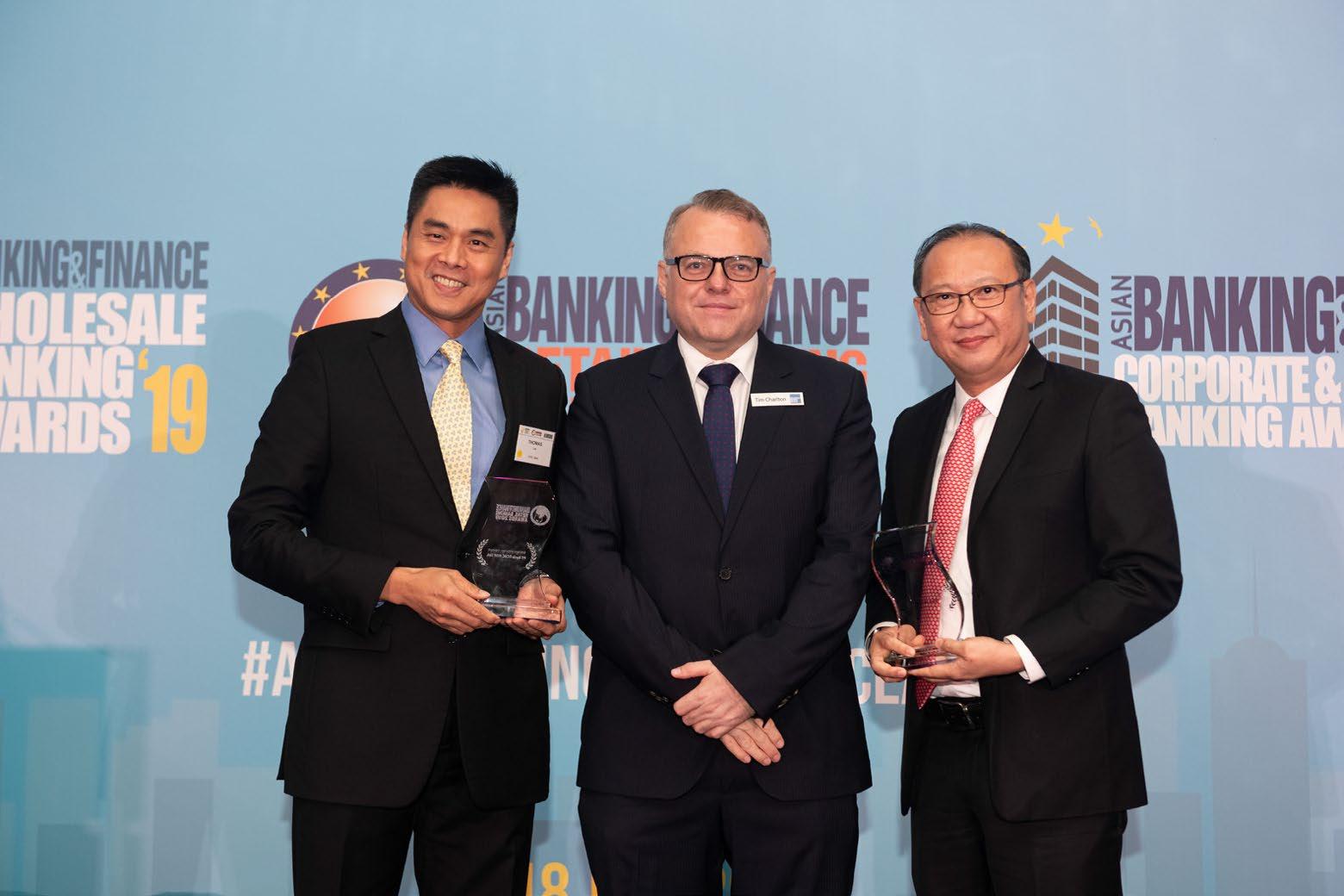
8 minute read
Why does it matter to banks in Singapore? Accelerating Indonesian microfinance with high tech and high touch
Accelerating Indonesian microfinance with high tech and high touch KASPAR SITUMORANG
Economic inclusion can seem like a faraway goal for many, if not most, countries around the world. Achieving it would mean being able to lift people out of poverty, create equality between genders and socio-economic backgrounds, and build socially inclusive futures for our children.
According to the World Economic Forum’s Inclusive Development Index 2018, the top-ranking countries for economic inclusion are Scandinavian, Nordic, and European countries. These are small countries, with populations of 8.57 million people or less—there are only 362,860 people in Iceland. In comparison, countries with far more dense populations find it harder to foster economic inclusion.
Indonesia sits at 36th place on the index under ‘Emerging Economies’—below fellow Southeast Asian countries Malaysia, Thailand, and Vietnam, but above the Philippines and Laos. However, this position is nothing to get too wound up about, because despite Indonesia’s incredibly dense population of 264 million and an archipelago terrain, we are still considered a slowly advancing economy.
The report notes that Indonesia lacks progress on inclusion indicators such as income and wealth inequality. In order to combat this, the country needs to take big leaps forward in terms of technology and financial inclusion. But to do this, it is imperative that plenty of attention, effort, and investment be paid to developing people, streamlining the training process, and deploying offline assets.
MFIs as agents of change
Modern microfinance institutions (MFIs) are in the best position to help, and by using the agent network model, they can be highly successful in spreading more financial inclusion and literacy to more Indonesians.
In this manner, high-tech and innovative systems must be well-synced with high-touch and welltrained manpower to run like clockwork. Agents established in rural areas are absolutely crucial to creating touch points needed for the local community to get educated and involved. These agents need to foster a strong sense of trust between the banks they represent and the people to whom we are trying to give basic financial service access.
As a case study, Baobab Madagascar (formerly Microcred Banque Madagascar) equipped its agents with a nano-loan product based on automated credit scoring. By 2017, agents accounted for more than half of the bank’s business, leading to a restructuring exercise to make agents its primary consumer channel. Madagascar’s case study proves that focusing on empowering agents with better tools to provide more services is deeply rewarding.
But this is not to say that keeping agents up-todate is an easy task. It’s far from easy to keep every agent’s mobile software current, especially those in truly hard-to-reach places. For this reason, modern MFIs should look into using satellites as a way of instantly keeping their agents’ apps relevant, functioning, and up-to-date.
In other words, the Goldeneye-like satellite beams wifi access straight down from space—no cellular towers needed. For us, it acts as a practical backbone for network stability. This, in turn, creates a financial ecosystem that connects and unites the entire country. It’s a big reason why we’ve been able to make progress in recent years. In 2019, our agent network known as BRILink produced a transaction volume of approximately $44.8b.
Thinking outside the vault
Simple, yet innovative thinking is also key for MFIs to meet their target customers wherever they are. Another example from our own bag of tricks is the first-ever ‘floating bank’ initiative, aimed at reaching people in the coastal areas and remote islands in Indonesia (with more than 17,000 islands, there are a lot of these areas afoot). A floating bank is exactly what it sounds like: a Bank BRI-owned ship that acts as a fully functioning bank branch at sea. To date, we have four of them on the water.
Starting collaborations and partnerships with companies that are making efforts to improve agent network models can also be a great way to strive for impact. By putting emphasis on creating a system in which high tech and high touch approaches work hand-in-hand, Indonesia can start to make significantly bigger leaps toward economic inclusion through financial literacy. Whilst Indonesia has already reached 75% financial inclusion, OJK surveys show that only 38% of Indonesians are financially literate. This means there is still much work to be done.
KASPAR SITU MORANG
Executive Vice President Bank BRI
RUPERT NAYLOR
Senior Vice President, APAC Mastercard
The New Normal: How digital forces will upend banking in Asia RUPERT NAYLOR
In the past 12 months, we witnessed a range of companies racing to qualify for a spot among
Singapore’s first digital banks, mirroring what happened with Hong Kong’s virtual bank licenses the year before. The sense of urgency is understandable— the nature of what it means to be a bank is changing, and this shift is opening a gap in which newer operators can assert themselves. The importance of this is underscored by the fact that the Asia Pacific region has an astonishing share of the world’s digitally native population; in markets like India, Vietnam and Thailand, it’s common to become “digitally banked” without having had a credit card—or even a bank account. While Asia Pacific is diverse in its financial systems, there are some unifying factors which are going to change the face of banking across the region.
Here’s what we see as the most important ones.
Keeping an open mind: Financial institutions take a contemporary approach to open banking
Open banking is catalyzing systemic and far-reaching change across the global financial services industry. Banks have responded by shifting away from the traditional approach to innovation that starts with the legacy technology stack, to a consumer-focused approach based on design thinking that enables more rapid innovation—failing fast where necessary. In Asia, where speed-to-market is absolutely critical, we’re also seeing a greater willingness amongst banks to partner with industry players to accelerate innovation. DBS’s Developers API Hub is a prime example of how Singapore is leading the way.
In addition to stimulating innovation and competition, open banking is also building a collaborative ecosystem in which consumer consent drives the sharing of data between financial institutions and fintechs, while enabling benefits for those consumers. And this is where we see a monumental shift taking place. The most successful players will be those who deliver the greatest value to consumers in the form of superior products, services and by using their personal data responsibly.
For consumers, technology has transformed their expectations across multiple dimensions ranging from bespoke offers and rewards, to the convenience of digital experiences, to how products and services should be tailored to their personal preferences. is these ever-higher standards and increasing expectations that are driving the innovation race in Southeast Asia and across the world.
Cat and mouse game: How banks are keeping hardworking cybercriminals at bay
More than half of the companies in Asia Pacific have experienced a cybersecurity breach or are unaware if one has taken place at all—leading to potential economic losses of US$1.745t across the region.
With most parts of Asia being mobile-first markets, banks are racing to make superior digital banking solutions. The proliferation of wallets and the introduction of open banking in various formats will accelerate this trend. While these devices open up a huge vector for cyberattacks, banks need to invest in cutting-edge technologies that include device binding and behavioral biometrics to keep their consumer interactions safe and secure. As risks mount, banks are developing comprehensive cybersecurity strategies that proactively protect consumer. In Southeast Asia, where one data breach can cost an average of US$2.62m, failure to act can cause longterm damage to a bank’s finances and reputation.
Efficient and effective cybersecurity strategies should be contextually embedded at every level of an institution and at the outset of any new offering.
Cashless is king? How going cashless drives financial inclusion and inclusive growth
In Southeast Asia, nearly three-quarters of adults don’t have a formal bank account, while 33% of businesses in the region lack proper financing to grow their businesses and plan for the future. At the same time, Asia Pacific’s payments market is on track to grow to twice the size of any other regional payments market in the world, with digital banks and fintechs helping to lower the barriers to financial inclusion and mobile payments becoming more accessible.
Victory in the digital banking/fintech battle will ultimately be decided by players’ ability to foster financial inclusion, rather than continuous technological advancement. Once these businesses have captured large portions of more technologically sophisticated consumers, they will have to expand outwards, rather than upwards, and that will mean gaining a greater understanding of the needs of populations who are far removed from any kind of formal banking system. The incentives need to be clear for these prospective customers to make the jump into a truly foreign ecosystem, but for those companies that are able to connect these dots, the potential payoffs are substantial—both for the businesses themselves, and for the broader economy.
RECOGNISING THE BEST OF THE BEST IN THEBANKING &FINANCE INDUSTRY




NOMINATE NOW
Digital transformation for today’s challenging landscape
Our customers tell us that they need to use transformative digital strategies to remain relevant in today’s challenging financial landscape. Strategies that will allow them to improve operational control, reduce costs, build new revenue streams, mitigate risk and comply accurately with regulation. To help you make the journey towards digital transformation, we provide a range of solutions for the transaction lifecycle. AI and Blockchain technologies are now embedded in all of our solutions, which are also available in a variety of deployment models. Digital transformation. Reaching the summit just got a little easier.

www.smartstream-stp.com






